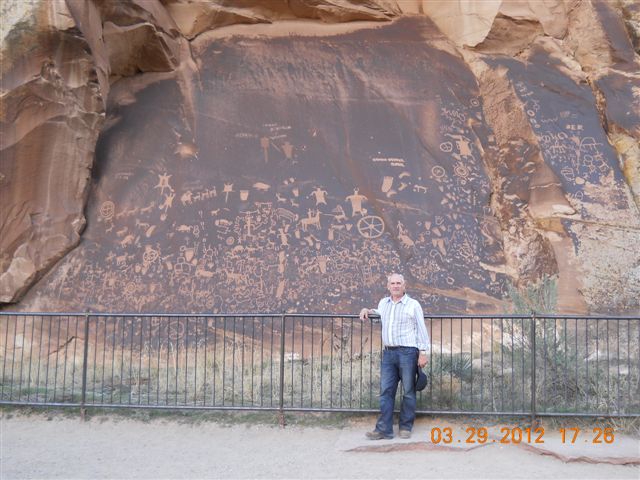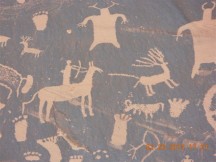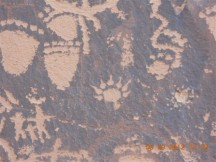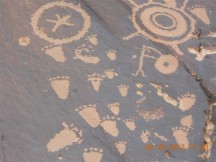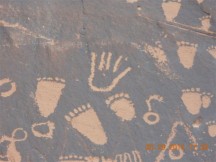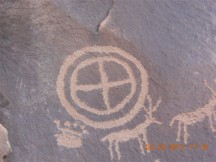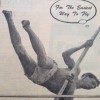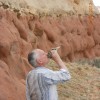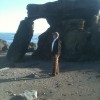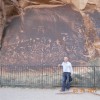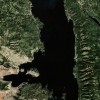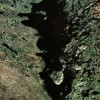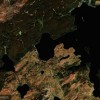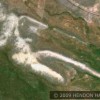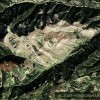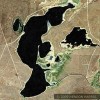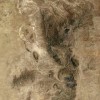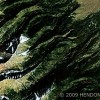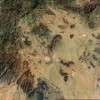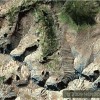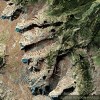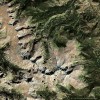
Are There Ancient Buddhist Symbols on Newspaper Rock?
Posted on Tuesday, April 24th, 2012
Images of the petrogyphs on Newspaper Rock are readily accessible as are the topics of Buddhapada (Buddha’s footprints) and their impact on ancient Buddhism as well as the Concentric Circles (Mandalas) of Buddhism and their usage in both the Wheel of Life (Six Spokes) and the Dharmachakra (Wheel of Law) which has Eight Spokes and is probably the best known Buddhist symbol.
I have recently returned from a trip to southeast Utah where I was able to travel to Newspaper Rock near Canyonlands National Park. It was an informative experience and I will share more details of the trip in future postings.
Buddhism originated in the late 6th century B.C.E. in India. It did not reach China until very early in the Common Era. From its origins up to the time that Buddhism reached China it was prohibited in Buddhism to make artistic images of the actual body of Buddha.
Because of this prohibition and because Buddhist art was an important tool in Buddhism symbols were extremely significant to Buddhist devotees in spreading their message wherever they travelled.
These symbols were/are many and can be accessed by “googling” Buddhist Symbols. They include but are not limited to the Dharmachakra, The Eight Auspicious Symbols, the Wheel of Life, the Lion, the Mudras (hand gestures), the Mandala (Medicine Circle and Medicine Shield), concentric circles and the footprints of Buddha, the Chattra (Sanskrit for mushroom) which is the revered Buddhist symbol of protection as well as numerous others.
I went to Utah looking for possible evidence of ancient Buddhism in that area and I believe that at least some of the petroglyphs at Newspaper Rock may point in that direction.
Here is the evidence that I believe needs to be further researched by experts in these fields.
- Buddhapada (the study of the ancient carvings of the footprints of Buddha) is a significant field of study. Several scholars of Buddhism have made Buddhapada their life’s work. Unfortunately little or no time has been given to such carved footprints in North America because the possibility of the ancient travel to the Americas by Buddhists is not a widely held theory. But footprints are all over Newspaper Rock!
- Concentric Circles are a very important part of Buddhism and of the Mandalas in which they play an extremely important function. When I first located the six spoked wheel with the large hub in the middle (it’s just to the right of the horseback archer who has an inflight arrow on the way toward his intended elk target) I was confused. I did not know at that time of the Six Spoked Buddhist Wheel of Life. (Wheel of Life, Dazu Stone Carvings, China). The Wheel of Life is an important and yet lesser known symbol of Buddhism than many other far more popular images. There are wheel images all over Newspaper Rock!
- Then there is possibly one Mudra (hand gesture) at the same level as the Six Spoke Wheel just further to the right and above three footprints. I don’t know the meaning of this particular hand print but I believe it warrants analysis by Mudras experts.
I will acknowledge that these footprints, concentric wheels and the hand print on Newspaper Rock are in a cruder form than similar art found in India, Southeast Asia and China. But could this be because these carvings were done earlier than the other examples found in Asia or because these North American artists were less skilled than their Asian based counterparts? How can we get experts in Buddhism to research this as well as the geoglyphs near Egnar, Colorado just a few miles away.
I will close this posting with a couple of ongoing North American mysteries-
A) Although it is obvious from Newspaper Rock that Native Americans were aware of the wheel, there is no record that they used the wheel for anything other than religious art. Why would anyone not use the wheel who was aware of it?
B) It is also obvious that because of the images of Native Americans on horseback for hunting and travel on Newspaper Rock that at least at the time this art was carved that they had horses which although mentioned in the Buddhist Monk’s (Hwui Shan) journal in 499 AD are claimed not to have been available to the natives by mainstream scholars until the Spanish bought them to North America in the early 16th century.
The way Meso American scholars currently explain mystery (B) is to say that this art is relatively recent. At least sometime after the Spanish arrived here and had brought the horses.
How can these apparent Buddhist symbols used so frequently half a world away be discounted with no research to establish their age or source of origin when so much advanced technology to research this is readily available?
I believe that the lack of use of the wheel for utilitarian purposes by Native Americans throughout the Americas and the scarcity of horses as well is connected and is alluded to in the ancient Chinese book I Ching and the Chinese legend of the 10 Sun/Ravens but that’s a story for another time.
The Beak of the 10th Sun/Raven- STILL GLOWS!
